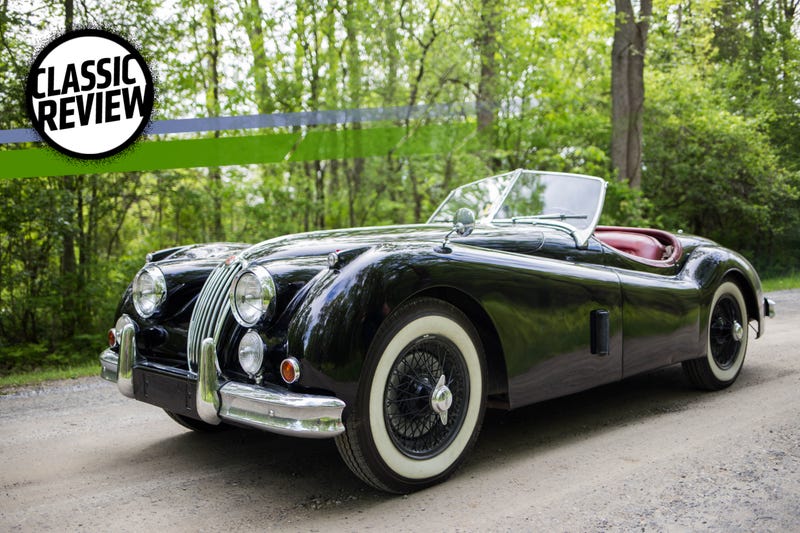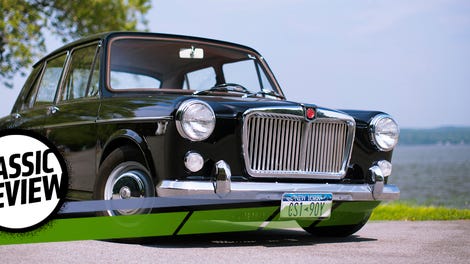
The stop sign was approaching.
“You should start braking,” Teresa, the owner of the 1956 Jaguar XK140 Roadster I was driving, cautioned from the passenger seat.
I applied a normal amount of pressure to the brake pedal. Nothing happened.
“More, brake more,” Teresa said again, this time some urgency creeping into her tone.
Advertisement
I pushed harder and the car still did not slow. We had almost reached at the intersection. Oh, god. Fighting panic, I threw my entire weight behind my right foot, stamping down hard on the brake. Gradually, the car rolled to a stop, its nose sticking slightly too far out into the road. At least no one was coming.
(Full disclosure: I wanted to drive Teresa’s 1956 Jaguar XK140 Roadster so badly that I asked her and she said yes.)
Though the second World War was very much over by 1956, many countries still reeled from it. The United States was the most influential economic power at the time, in part because much of our infrastructure hadn’t been bombed to hell. The same couldn’t be said of our ally, Great Britain, which the war left financially crippled, despite victory.
The British government had exhausted its funds in order to defeat its enemies and the country desperately needed money to rebuilt itself. As a result, the government began an economic push post-WWII for all its manufacturers (including Jaguar) to export their goods to other countries, which marched to the rallying cry of, “Export or Die.” The British Motor Industry produced over half a million cars at the beginning of the 1950s. Nearly 400,000 of them came here.
Advertisement
American demand for the Jaguar XK120 in particular spiked in 1950 after Phil Hill won first place in one at a race in Pebble Beach, California. American buyers, especially those who were deployed overseas in Britain, were already familiar with sporty British cars like MGs. They were very taken with the Jaguar roadster’s looks, power and endurance capabilities.
The XK140, the successor to the iconic XK120, remained largely the same, but with certain improvements. Heavier, polished bumpers lined its front and rear. Inside, it was slightly larger and more comfortable. It came in three versions: Roadster, Fixed Head Coupe and Drophead Coupe. They had four-speed manuals and, later on, became the first Jaguar sports car to offer an automatic transmission.
And the engine was upgraded. Beneath the XK140’s gloriously long hood was a 3.4-liter, cast-iron block inline-six with two SU carburetors, an aluminum head and dual-overhead camshafts and valves—good for a claimed 210 horsepower.
There was no power steering. No power brakes. A non-synchronized transmission. If there were turn signals, they weren’t working when I took the car out.
After I climbed into the driver’s seat, I discovered to my dismay that I was too short to sit comfortably and still be able to push the clutch all the way in. So I did what I had to and pressed my shoulder blades against the backrest and scooted up to the edge of the seat to reeeeeeach for the pedals. I really had to put my back into it.
And after 20 minutes of driving the XK140, I was already convinced: drivers these days have it so easy. I am aware this makes me sound like a jaded old lady, stuck in some decades-ago yesteryear.
Advertisement
The clutch engaged high off the floor and it wasn’t a terribly easy feat to get there each time. It was heavy. The thin and knobbly shifter didn’t provide the same kind of confidence that a shorter throw shifter did. Slow-speed turns were a full upper body workout. You really appreciated the large-diameter steering wheel—the size of a big pizza—to crank during those turns.
Every downshift from third was followed by a subsequent hunt for second. Sometimes the shifter didn’t slot into the gate immediately. Sometimes the gears ground anyway, even though I had done everything correctly.
But every moment of it was maddeningly lovely. It made driving more of a craft to perfect than I had ever experienced before. The car’s 61-year-old mechanicals whirred and clunked around me as I felt the transmission out. Tested the brakes. Learned the throttle. Fought with the steering.
Advertisement
Each time I got something right, it was like a small slice of victory. Finding the right piece of that puzzle. It was a traceable and tangible sensation of progress and it was righteous.
Last year, I drove a 2016 Jaguar F-Type R Coupe—which could be seen as a descendent of this XK140. But, really, the only similarity between those two cars is the name written on their noses. The F-Type, and all other modern cars like it, are laughably easy to drive. All you have to do is point it in the right direction and you could drive it with a finger.
The XK140’s demands on you are absolute. Your body, entire. Your attention, total. And your patience. But get behind the wheel of one and you’ll gladly let it have it all.
















